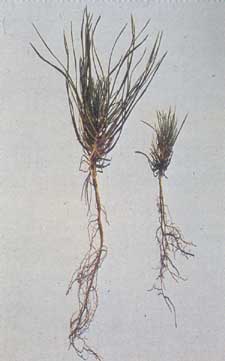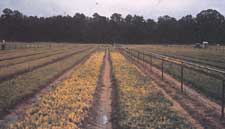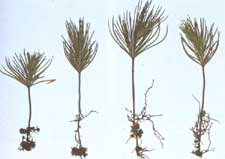NematodesJohn L. Ruehle - Plant Pathologist, Southeastern Forest Experiment Station, USDA Forest Service, Athens, GA, and Cordell C.E., Anderson R.L., Hoffard W.H., Landis T.D., Smith R.S. Jr., Toko H.V., 1989. Forest Nursery Pests. USDA Forest Service, Agriculture Handbook No. 680, 184 pp. Hosts Seedlings of all tree species are susceptible, at least to some degree, to plant-parasitic nematodes. The nematodes most damaging in forest nurseries include root-knot nematodes, Meloidogyne spp.: pine cystoid nematodes, Meloidodera spp.; lance nematodes, Hoplolaimus spp.; lesion nematodes, Pratylenchus spp.; stunt nematodes, Tylenchorhynchus spp.: stubby-root nematodes, Trichodorus spp.: and dagger nematodes, Xiphinema spp. Some parasitic nematodes have a wide host range, feeding on many different forest tree species. Others have more restricted feeding habits. Distribution Plant-parasitic nematodes occur in forest nurseries throughout the United States. Because cool temperatures are unfavorable to most species, root-knot nematodes are not important parasites in the Northern States. Conversely, certain pathogenic species of lesion nematodes-effective pathogens in colder regions-are rarely found in southern nurseries. Damage Nematodes seldom kill seedlings outright. They may, however, severely debilitate the plant through partial destruction of the root system. Wounds caused by nematode attack may serve as points of entrance for root pathogens such as Fusarium spp. The resulting disease complex may then cause significant mortality. Damage Nematodes seldom kill seedlings outright. They may, however, severely debilitate the plant through partial destruction of the root system. Wounds caused by nematode attack may serve as points of entrance for root pathogens such as Fusarium spp. The resulting disease complex may then cause significant mortality.
The underground root symptoms vary with the nematode species. Root-knot nematodes may cause galls on the roots (fig. 43-3) and, roots near the galls. On certain hosts, dagger nematodes cause galls and bending of lateral roots. Pine cystoid nematodes cause few, if any, galls and are visible only when the swollen females erupt through the roof epidermis. In contrast, lesion nematodes cause a necrosis of the cortex, which results in a general decay of the feeder roots. The lance nematode- an internal parasite particularly damaging to pine seedlings-also migrates through the cortical tissue and causes extensive internal cell destruction, which allows other pathogens to enter and further damage the root system. Nematodes that do not enter the roots generally have less obvious effects on free seedlings. Stunt, stubby-root, and dagger nematodes cause discoloration and surface lesions. The most frequent effect of their feeding is a general stunting of lateral roots without noticeable decay. Nematodes are submicroscopic, slender, white worms. Specialized laboratory equipment is required to extract them from plants and soils. Identification to genus and species usually requires the services of a nematologist. Biology All plant-parasitic nematodes have a stylet at their anterior end. They use this sharp-pointed tube to puncture plant cells and remove cellular contents. Some species feed internally in the feeder roots: others remain at the root surface and feed externally. These feeding wounds provide entry points for other pathogens. The resulting disease complex may destroy more seedlings than a single pathogen acting alone. Control Cultural - Crop rotation controls certain nematodes. In the rotation sequence, favor crops that are not susceptible. For example, where root-knot nematodes are a problem, rotation with fescue, a non-host, is recommended over soybeans, a host. Chemical - Fumigate the soil before seeding to control nematodes in forest nurseries. Methyl bromide is one of the most effective soil fumigants and provides excellent control in most nurseries. When nematodes are a problem in isolated nursery sections, spot injection with less volatile nematicides provides satisfactory control. Dip roots of infected hardwoods in chemical solutions to control root-knot nematodes. A 15-minute dip in fensulfothion has been effective in protecting catalpa and dogwood. Immersing bare roots in hot water at 126 0F for 2 minutes has controlled lesion nematodes infecting eastern redcedar. Selected References Peterson, Glenn W. 1962. Root lesion nematode infestation and control in a plains forest tree nursery. Res. Note 75. Fort Collins, CO : U. S. Department of Agriculture. Forest Service. Rocky Mountain Forest and Range Experiment Station. 2 p. Ruehle, John L. 1975. Nematodes. In: Peterson, Glenn W.; Smith, Richard S., Jr., tech. Cords. Forest nursery diseases in the United States. Agric. Handb. 470; Washington, DC: U.S. Department of Agriculture: 31-34. Ruehle, John F. 1973. Nematodes and forest trees - types of damage to tree roots. Annual Review of Phytopathology. 11: 99-118. Sutherland, Jack H.; Adams, H.F. 1964. The parasitism of red pine and other nursery crops by Tylenchorhynchus claytoni Steiner. Nematologica . 10: 637-643. |
Forest Pests: Insects, Diseases & Other Damage Agents |

|
|




